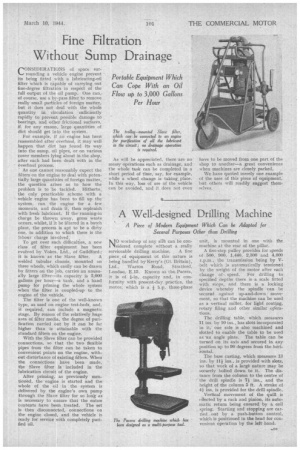Fine Filtration Without Sump Drainage
Page 23

If you've noticed an error in this article please click here to report it so we can fix it.
Portable Equipment Which Can Cope With an Oil Flow up to 3,000 Gallons Per Hour
CONSIDERATIONS of space surrounding a vehicle engine prevent its being fitted with a lubricating-oil filter which is capable of carrying out fine-degree filtration in respect of the full output of the oil pump. One can, of course, use a hy-pass filter, to remove really small particles of foreign matter, but it does not deal with the whole quantity in circulation sufficiently rapidly to prevent possible damage to hearings, and other frictional surfaces, if. for any reason, large quantities of dirt should get into the system. For example, if an engine has been reassembled after overhaul, it may well happen that dirt has found its way into the sump, oil pipes, or on various cover members lying about in the shop, after each had been dealt with in the overhaul process. As one cannot reasonably expect the filters on the engine to deal with potentially large quantities of foreign matter, the question arises as to how the problem is to be tackled. Hitherto, the only practicable scheme with a vehicle engine has been to fill up the system, run the engine for a few moments, and drain it, then replenish with fresh lubricant. If the running-in charge be thrown away, gross waste occurs, whilst, if it be filtered in a batch plant, the process is apt to be a dirty one, in addition to which there is the /aboutcharge involved. To get over such difficulties, a new class of filter equipment has been evolved by Voiles, Ltd., of Guildford; it is known as the Slave filter. A welded tubular chassis, mounted on three wheels, which easily can be drawn by fitterson the job, carries an unusually large filter—its capacity is 3,000 gallons per hour—a tank, and a hand pump for priming the Whole system when the filter is coupled-up to the engine of the vehicle. The filter is one of the well-known type, as used on engine test-beds, and, if required, can include a magnetic stage. By reason of the relatively huge atea of filter media, the degree of purification carried out by it can be far higher than is attainable with the standard filters on the engine. With the. Slave filter can be provided connections, so that the two flexible pipes from the filter can be taken to convenient points on the engine, without distarbance of existing filters. When the connections have been made, the Slave filter is included in the lubrication circuit of the engine. After priming, as previously mentioned, the engine is started and the whole of the oil .in the system is delivered by the engine's own pump through the Slave filter for so long as is necessary to ensure that the entire contents have been, treated. The set is then disconnected, connections on the engine closed, and the vehicle is ready for service with completely purified oil. As will be appreciated, there •are no' messy operations such as drainage, and the whole task can be completed in a short period of time, say, for example, while a wheel change is taking, place. In this way, loss of use of the vehicle can be avoided, and it does not even have to be moved from one part of the shop to another—a great convenience when machines are closely parked. We have quoted merely one example of the uses of this piece of equipment, hut others will readily suggest .themselves.




















































